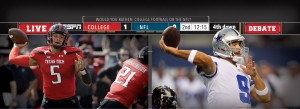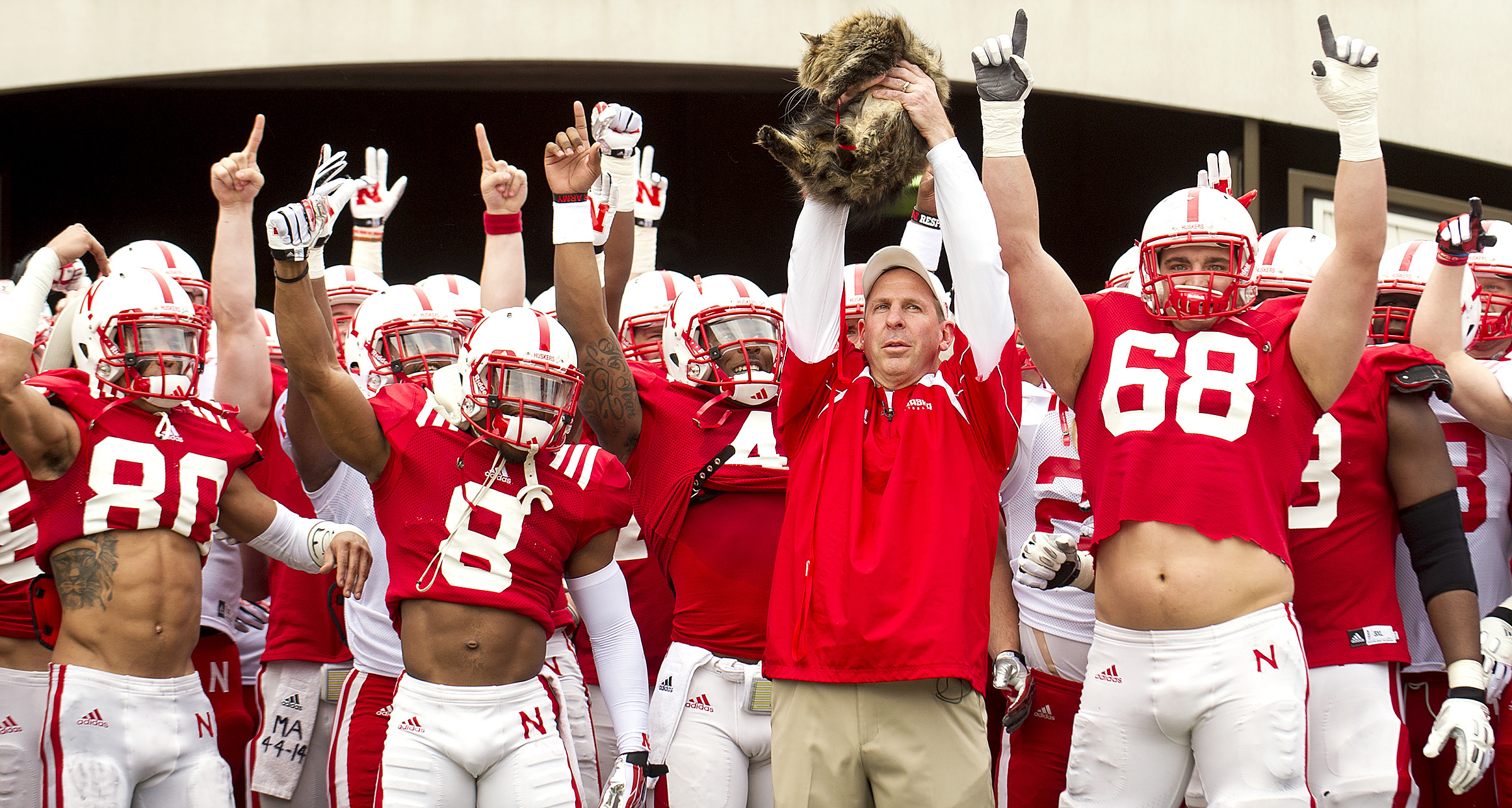Football vs. Football
Weighing the merits of college and professional football, completely un-objectively.
By Will Strecker, The University of Texas at Austin
It’s a question that every football fan will have to answer at some point in their life: NCAA or NFL?
For me, the answer has always been clear. College football is everything that makes the game great—the fans are passionate, the games are fast paced, exciting and fun, and the players are motivated by all the right reasons.
And yes, I know that ultimately this is just an opinion, but isn’t everything technically just an opinion? Before you think too much about what I just said read further into the article. Look, I’ve included a lot of stats—there’s no way this is just an opinion! This, this is the truth.
First, I will dismantle one of pro football’s favorite arguments—that NFL players are more talented. I don’t contest the statement—it’s true that the talent level in the NFL surpasses that of the NCAA, but that should be obvious: consider the odds of a high school football player making it to the NFL.
In high school, there are just under 1.1 million athletes playing football, which means about 310,000 of them are seniors.
In college, there are 70,000 student athletes playing football, but only about 20,000 open freshman roster spots.
So of the 310,000 high school seniors that will graduate, only 20,000 will make it to the NCAA, meaning only 6.5 percent of players make that transition, only 2.5 percent of which are going to Division I schools.
Of these 70,000 college football players, there are about 15,000 seniors. In college, though, it’s not just seniors that get drafted. The NFL selects 256 players every April, but many of them are juniors, redshirt juniors and redshirt sophomores, meaning that a scant 1.6 percent of college football players make it to the NFL.
The percentage, then, of high school players that make it to the NFL is a skinny 0.08 percent, the same likelihood of having an IQ of 150. In other words, it’s hard to make it to the NFL.
All this proves, however, is that pro football players are more talented than their collegiate counterparts, not that they’re any more entertaining.
In fact, the preponderance of talent in the NFL actually has a negative effect on the game’s entertainment value. Bear with me.
Take, for instance, the common argument that holds the parity of teams and players in the NFL as a reason for its superiority. Because the NFL is so selective, the reasoning goes, there isn’t much of a difference in talent between players. Most often, the difference between an elite player and an average player in the NFL lies only in the player’s work ethic and football intelligence.
With such a negligible disparity in talent, the strategic component of the sport becomes more vital, and the X’s and O’s begin to dictate wins and losses. Again, this isn’t necessarily a good thing. An average fan only pays attention to the ball flying up and down the field, players leaping and scoring touchdowns, big tackles and botched extra points: only a small percentage of fans care about the mental game within the game, all the film-watching and chessboard positioning that Rex Ryan still considers to be frou-frou magic.
Balanced teams theoretically make for better, more exciting football, but it’s not so true in practice. What fans really want is action. They want to see a back and forth frenzy of explosive plays, not a stalemate between a wide receiver and cornerback whose skills cancel each other out. (“That DB is so dangerous that he’s never even made a play.”)
Now is when Chris Hardwick would yell out “Points!” on his stupid At Midnight show, but c’mon, I want to see points, you want to see points, everyone wants to see points! And thus I gracefully sidestep out of your line of vision, focusing your attention with my hands on the NCAA, a league in which the top 44 teams all averaged more points than league-leading New England did last year (Baylor led the nation with 46.4 points per game while New England averaged 30.4 points). That’s more than a two-touchdown-per-game difference.
A phrase that—like kickers, guns and deflated footballs—gets nonchalantly tossed around the NFL, is that it’s “the last eight minutes of a game that count.”
In fact, aside from piling up fantasy stats, you could easily say that the last eight minutes of NFL games are all that counts.
College football, on the other hand, precisely because there is such a wide discrepancy in talent, produces breath-taking and awe-inspiring plays nearly every week at any moment, not just in the last eight minutes.
Of course, when a team scores a game-winning touchdown on a Hail Mary as the clock expires (RIP Doug Flutie) or in overtime (which is better in college anyway), it’s even more exciting than when the same thing happens in the pros. This is because there are fewer games in college, four times as many teams and losing even one game can completely derail a season. That means that every play—the big ones included—carry more weight than they do in the pros.
Don’t get me wrong—I’m not saying defense isn’t exciting. But there’s something elegant about watching an offense click, gaining first down after first down on their way to the end zone.
In 2014, Marshall led the NCAA in yards per play with 7.3. What’s more, the top 30 college teams in the nation all averaged over 6 yards a play. By contrast, Pittsburgh led the NFL with only 6.1 yards per play, while Oakland, last in the league per unspoken mandate, averaged only 4.5 yards per play. In the NCAA, we don’t see a team get to Oakland Raiders levels of haplessness (averaging less that 4.5 yards per play) until we get to Penn State, ranked 120th out of 128 teams.
 Plus, Wake Forest—the Oakland of college football—only averaged 3.0 yards per play, meaning that in college there’s a 4.3 yards per play differential between the nation’s leading team and the team in last place. In the NFL, that yards per play differential is a measly 1.6 yards. This also means that there are 120 college teams that average as many or more yards per play as all of the NFL teams. That makes for 60 games per weekend (without factoring in bye weeks) where we see college teams moving the ball at least as efficiently as they do in the NFL. This makes for better football, and more of it.
Plus, Wake Forest—the Oakland of college football—only averaged 3.0 yards per play, meaning that in college there’s a 4.3 yards per play differential between the nation’s leading team and the team in last place. In the NFL, that yards per play differential is a measly 1.6 yards. This also means that there are 120 college teams that average as many or more yards per play as all of the NFL teams. That makes for 60 games per weekend (without factoring in bye weeks) where we see college teams moving the ball at least as efficiently as they do in the NFL. This makes for better football, and more of it.
So yes, professional teams are more balanced, and yes, in any given week, any team can lose and any team can win. This adds an element of unpredictability to the NFL that can be exciting, but at what cost? In the playoffs, no one is surprised when a sixth seed beats a number one seed, because a balanced league means a dearth of underdogs.
There is no David overcoming Goliath storyline—the 2007 Patriots went 18-0 and still lost—and therefore no opportunity for the elation that comes with such an odds-defying win, the kind of ecstasy that leads thousands of screaming fans to storm the field, pull down goal posts and celebrate together, united by their football team.
It gets better: across almost all statistical categories, college teams have higher averages and a greater statistical discrepancy between the leading team and the last team. Last year, Baylor led the nation with 569.9 yards per game, and the next eight teams all averaged over 500 yards. In the NFL however, New Orleans led the league with 411.4 yards per game—significantly fewer than the college leaders. Houston was the first college team to average under 411 yards last season (410.2) and they were 56th in the nation in offense.
A big reason for this is that college teams average more plays per game than the NFL (Baylor led the nation with 90.3, whereas Philadelphia led the NFL with 70.7), but even this fact says something about the NFL. Granted, in college, the clock stops with a first down until the ball is set by the refs, but that doesn’t equate to 20 phantom plays. And an average NFL game last 3 hours and 15 minutes, whereas a college game last about 3 hours and 20 minutes, also not a large enough difference to warrant 20 extra plays, not to mention 150 more yards per game. The bottom line is that fans get more of what they want in college football: entertainment.
All my arguments leading up to this point have avoided the Roger Goodall in the room, but the seedy underbelly of the Nation Football League is an unavoidable topic of conversation in any comparison of the leagues.
Without going into off-the-field skeletons in the NFL’s closet (the NCAA has its own Art Briles to deal with), it’s worth noting that Goodall—and the NFL at large—is not only a business, but a league of businesses. This fundamentally differentiates the two leagues.
Within the NFL, each team is a privately owned, profit-driven company (aside from the publically owned Green Bay Packers, of course). Each player and coach on a team is an asset to that team, helping achieve the goal of bringing in more money for the team by doing his best to improve the team—each team being the NFL’s product.
If at any point that asset (player or coach) turns from boon to bane, it must be replaced with a better asset. General Managers are the automatons responsible for making these personnel moves in hopes of optimizing their product, but like the executioner’s executioner, not even the GM is safe from being replaced. Case in point—the Cleveland Browns front office. At its core, this is how the NFL works: owners doing whatever’s necessary to put out the best product possible.
These decisions all revolve around the owners picking players and coaches objectively in order to produce the best product. In turn, these players and coaches interact with the fans, and so they’re what we think of when we think of a team. But on the drop of a dime, any decline in their ability to perform will lead to their excision from the team. Combine this fickleness with teams’ salary caps, and roster turnover keeps the league in a state of permanent impermanence.
It’s a similar story in college football, but different in critical ways. The college football landscape is constantly shifting, but for different reasons. Every few years there are new and exciting players making waves across the country.
When the face of the team graduates or is drafted, there’s no feelings of resentment—it’s inevitable that everyone who joins the team will leave in a few years. And once they leave, there’s no animosity or ill will, just a fond memory of their contribution to the legacy of the university.
Unlike many NFL players, student athletes aren’t motivated by money. DeMarco Murray—a beacon of optimism for Cowboys fans everywhere—chose to leave Dallas for more money in Philadelphia after being offered a less than perfect contract from the Jones organization. Money dictates the entire NFL landscape, but only certain aspects of the NCAA.
Consider all this and it becomes clear that college football has an edge over the NFL. Football fans get more bang for their buck, and they don’t have to feel like they’re part of a corrupt system to enjoy the sport. Both institutions have their faults, but the college system stays truer to the essence of the sport.

















[…] than college and any team can win on any given Sunday, adding an element of unpredictability but a balanced league means a dearth of underdogs and few epic David overcoming Goliath storylines. It also means there […]